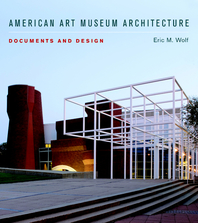
American Art Museum Architecture
Documents and Design
6 August 2010
Territory Rights — Worldwide.
Description
Exploring the intersections of art, architecture, and design, at both renowned institutions and cutting-edge contemporary collections.
Museum interior spaces must be as carefully designed as their façades—if not more so—to meet the needs of both the art on display and the viewers. The design and construction of art museums in America thus is a complex process, and one rarely undertaken lightly. The architect must design a building that effectively supports the art exhibited. The museumgoers’ interaction with the art must be enhanced by the architecture, while amenities such as restaurants, cafes, gift shops, and accessible and convenient restrooms ensure their comfort. Finally, the storage of works of art not on display must be accounted for in the building design.
American Art Museum Architecture: Documents and Design explores all aspects of, and approaches to, museum architecture—the aesthetic, the practical, the innovative, and the functional. Architectural historian Eric M. Wolf delves into the archives of some of the country’s premier institutions not only to explore the design decisions made at their founding, but also to understand how those institutions have continued to evolve along with their collections, up to the present day. Wolf examines the gradual development of six major museums: the Frick Collection, the Museum of Modern Art, and the Whitney Museum of American Art in New York; the Menil Collection in Houston, the Georgia O’Keefe Museum in Santa Fe, and the Art Institute of Chicago. He explains how each museum was originally conceived, how the architecture reflected or modified that original conception, and how the buildings have been reconsidered or revised in later years, as the nature of art, art display, and museum-going has evolved. Extensive archival plans, documents, and photographs enhance the narrative.
American Art Museum Architecture also considers the unique architectural challenges often posed by contemporary art. Conceptual art, video installations, and large-scale pieces are increasingly found in permanent collections, at small galleries and encyclopedic institutions alike. Museums built decades ago may have to renovate in order to accommodate such pieces, while newer museums devoted to contemporary work must tackle new architectural challenges when considering how best to house this work. Encompassing both grand nineteenth-century institutions and avant-garde contemporary art collections, American Art Museum Architecture is a timely and fascinating exploration of the ever-changing relationship between architecture and art.
Reviews
"[S]umptuously illustrated . . . ambitious in scope . . . Wolf offers another avenue for understanding design decisions, beyond referencing worldwide style changes or an individual architect’s aesthetic." — Journal of Design History
"[W]ell-organized and provides a great deal of in-depth information and analysis on the development of art museums in the United States." — ARLIS/NA Reviews
"[This] book makes the reader realize what it takes to create a truly great institution." — AmericanStyle Magazine
"[S]cholarly yet easily understandable…His articulation of the important considerations and events for each institution is clear and well integrated into the greater narrative for each museum…. [A]n insightful book on six American art museums, their architecture, and their clients." — A Weekly Dose of Architecture
""[R]ecommended for specialists in museum design as well as students."" — Colonial Latin American Historical Review


